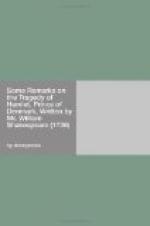Likewise, when Anonymous considers unity his emphasis, like Johnson’s and Hurd’s, is no longer on the mechanical unities but on unity of design. “When Shakespeare’s plan is understood most of the criticisms of Rymer and Voltaire vanish away,” Johnson was to write some thirty years later. Anonymous holds steadily for the integrity of Shakespeare’s plan in Hamlet. Of Act I, iii he says, “Concerning the Design of this scene, we shall find it is necessary towards the whole plot of the Play”; he speaks of I, iv as an “important Scene, on which turns the Whole Play”; the killing of Polonious, he explains, “was in Conformity to the Plan Shakespeare built his Play upon”; and finally, of the piece as a whole, he asserts that “there is not one Scene but what some way or other conduces toward the Denoument of the Whole; and thus the Unity of Action is indisputably kept up by everything tending to what we may call the main Design, and it all hangs by Consequence so close together, that no Scene can be omitted, without Prejudice to the Whole.” When one recalls that the idea of unity of design as evolved in Thomas Warton, Hurd, and Johnson was the intermediate step on the way to a full theory of organic unity we see the importance of such passages in the forward march of criticism.
There is in the Remarks a closer examination of event and character than is usual in the period, again in the light of what it reasonable and natural. The includes some “psychologizing” of persons in the play, specifically in partial analyses of Laertes, Polonious, and Hamlet, enough to foreshadow the later vogue but none of it very remarkable. More worthy of notice is the author’s use of a psychological method that is to reappear in developed form in Coleridge: that is, a study of successive scenes leading to a climactic moment—in this case Hamlet’s meeting with the ghost—for evidence of a skillful working up through right preparatory touches to a point where the audience, in the words of Anonymous, “are forced ... entirely to suspend their most fixed Opinions and believe ...” This may have been done before in criticism; but if so I do not myself recall it.
I should like, also, to risk the suggestion that to the author of Some Remarks should go the honor of the earliest adumbration of the “Hamlet problem.” For here, before Francis Gentleman or Steevens or Richardson, Anonymous has raised the tantalising question of the why of Hamlet’s conduct, the problem of his delay in effecting his revenge, and has glanced at an answer. Anonymous in no wise approves of Hamlet’s madness: it was, he thinks, the best possible way to thwart his design of revenge and it was carried on with unseemly lack of dignity. Shakespeare has followed his sources too closely, with bad results. There appears “no Reason at all in Nature, why the young prince did not put the Usurper to Death as soon as possible.” To be sure this would have ended the play; the poet must therefore delay the hero’s revenge. But, insists Anonymous, “then he should have contrived some good Reason for it.” This is clearly recognition of the vexing problem that has since occupied the attention of unnumbered critics—if not in full statement, at least in its essentials.




